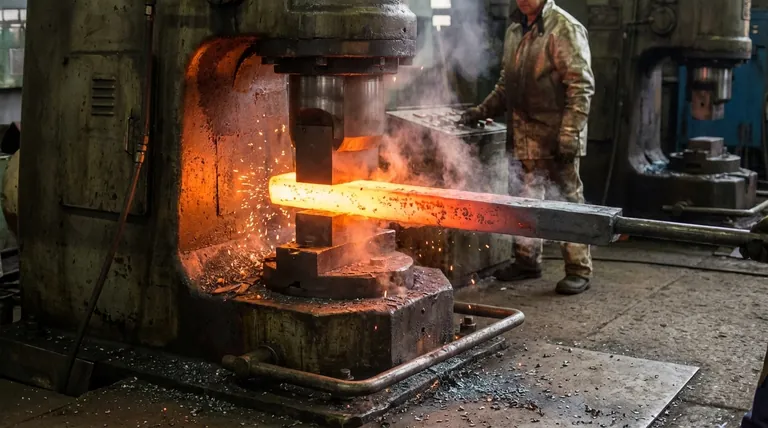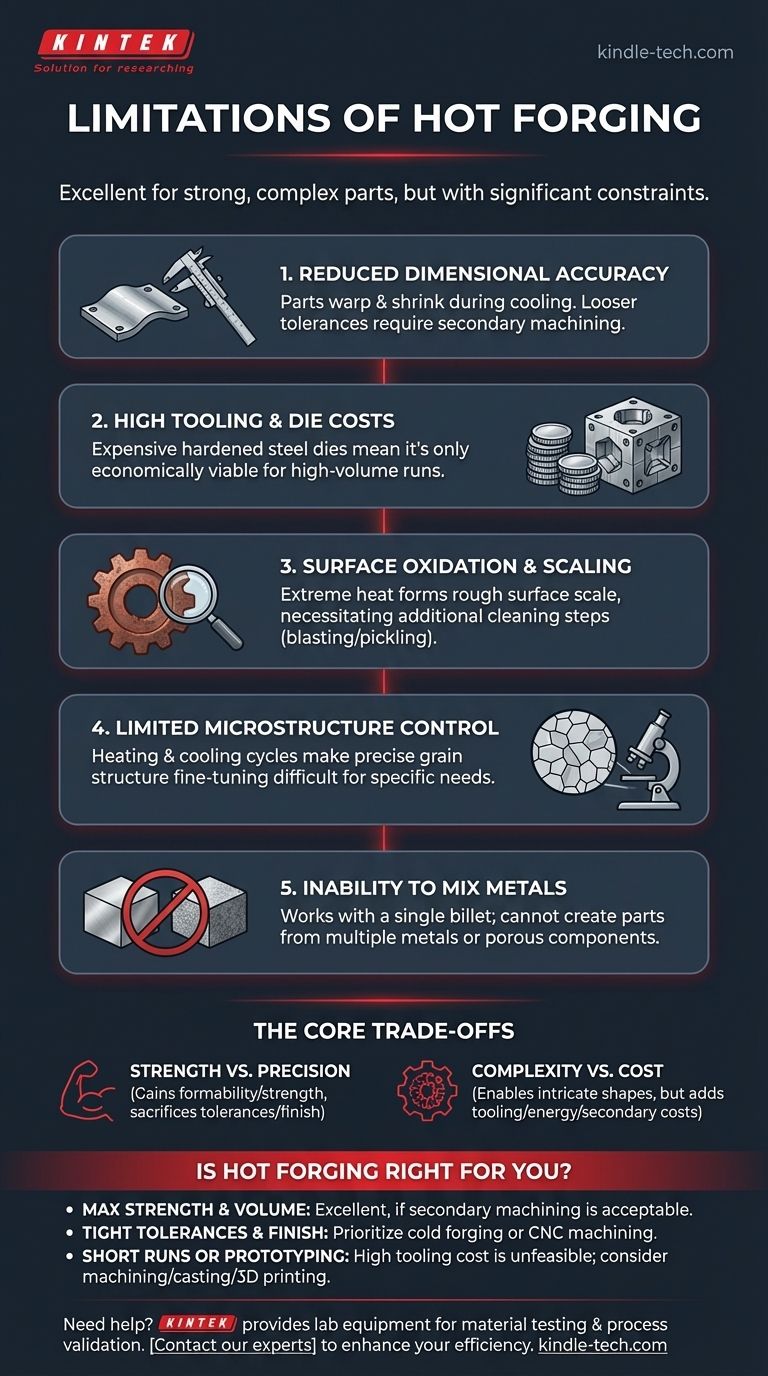While excellent for creating strong, complex parts, hot forging has significant limitations in precision, cost-effectiveness for small runs, and material control. The high temperatures required introduce challenges like reduced dimensional accuracy and the need for secondary machining, which adds to both cost and production time.
The core trade-off of hot forging is clear: you gain exceptional formability and material strength at the direct expense of dimensional precision, surface finish, and cost efficiency for low-volume production.

The Core Challenge: Heat and its Consequences
The defining characteristic of hot forging—its high temperature—is the source of its greatest strengths and its most significant limitations. The heat makes metal malleable, but it also creates variables that are difficult to control.
Reduced Dimensional Accuracy
As the forged part cools from a high temperature, it can warp and shrink unevenly. This results in looser tolerances compared to cold forging or machining.
Because of this, parts requiring high precision almost always need secondary machining operations to meet final specifications.
Less Precise Microstructure Control
The heating and cooling cycles inherent to hot forging make fine-tuning the material's grain structure (microstructure) difficult. This lack of precise control can be a limiting factor for applications with highly specific metallurgical requirements.
Surface Oxidation and Scaling
Exposing metal to extreme heat causes oxidation, which forms a rough layer of scale on the part's surface. This scale must be removed, typically through blasting or pickling, which adds another step and can affect the final surface finish.
Economic and Production Constraints
Beyond the metallurgical challenges, hot forging presents several economic hurdles that make it unsuitable for certain projects.
High Tooling and Die Costs
Producing the hardened steel dies required for forging is a very expensive and time-consuming process. This high initial investment is a major barrier to entry.
Unsuitability for Short Production Runs
Due to the high cost of the dies, hot forging is only economically viable for high-volume production runs. The cost-per-part for a short run would be prohibitively expensive.
Increased Energy and Equipment Costs
Maintaining furnaces at the required high temperatures consumes a significant amount of energy. Additionally, the process may require specialized equipment like presses with added features and fixture quenching systems, further increasing operational costs.
Understanding the Trade-offs
Choosing a manufacturing process is always about balancing competing priorities. Hot forging excels in some areas by sacrificing capability in others.
Strength vs. Precision
Hot forging creates exceptionally strong and durable parts by refining the grain structure of the metal. However, this comes at the cost of the tight tolerances and fine surface finish achievable with processes like CNC machining or cold forging.
Complexity vs. Cost
The process allows for the creation of intricate and complex geometries that might be impossible with other methods. This capability is paid for with expensive tooling, higher energy use, and the frequent need for costly secondary processing.
Material and Design Limitations
Finally, the nature of the forging process imposes fundamental constraints on the types of parts that can be produced.
Inability to Mix Metals or Create Porosity
Hot forging works with a single, solid piece of metal (a billet). It cannot be used to create parts from a mix of different metals, sintered carbides, or porous components like self-lubricating bearings.
Difficulty with Small, Intricate Details
While it can produce complex overall shapes, the process struggles to form very small, finely designed features. These delicate details typically must be added later through a separate machining operation.
Is Hot Forging the Right Choice for Your Project?
To make a definitive decision, evaluate your project's non-negotiable requirements against the inherent limitations of the process.
- If your primary focus is maximum strength and complex geometry in high volume: Hot forging is an excellent candidate, provided you can accommodate secondary machining for precision.
- If your primary focus is tight tolerances and a perfect surface finish: You should prioritize cold forging or CNC machining from the start.
- If your primary focus is a short production run or rapid prototyping: The high tooling cost of hot forging makes it economically unfeasible; consider machining, casting, or 3D printing instead.
Ultimately, selecting the right manufacturing process depends on a clear understanding of your design's most critical engineering and economic goals.
Summary Table:
| Limitation | Impact on Production |
|---|---|
| Reduced Dimensional Accuracy | Requires secondary machining for precision parts |
| High Tooling & Die Costs | Economically viable only for high-volume runs |
| Surface Oxidation & Scaling | Adds post-processing steps and affects finish |
| Limited Microstructure Control | Unsuitable for highly specific metallurgical needs |
| Inability to Mix Metals | Cannot create parts from multiple materials or porous components |
Need help selecting the right manufacturing process for your project? KINTEK specializes in providing advanced lab equipment and consumables to support your material testing and production analysis. Whether you're evaluating hot forging, cold forging, or machining, our solutions help you validate material properties and ensure quality control. Contact our experts today to discuss how we can enhance your manufacturing efficiency and achieve your engineering goals.
Visual Guide

Related Products
- Vacuum Hot Press Furnace Machine Heated Vacuum Press
- 24T 30T 60T Heated Hydraulic Press Machine with Heated Plates for Laboratory Hot Press
- Manual High Temperature Heated Hydraulic Press Machine with Heated Plates for Lab
- Heated Hydraulic Press Machine with Heated Plates for Vacuum Box Laboratory Hot Press
- Heated Hydraulic Press Machine with Heated Plates for Vacuum Box Laboratory Hot Press
People Also Ask
- What is hot press forging? Creating Complex, High-Strength Metal Components
- What is the main function of hot press forming? Achieve Superior Strength & Precision in Manufacturing
- What products are made by hot pressing? Achieve Maximum Density and Performance for Your Components
- What is pressure-assisted sintering? Achieve Denser, Stronger Materials Faster
- What is vacuum hot pressing? Achieve Maximum Density & Purity in Advanced Materials



















